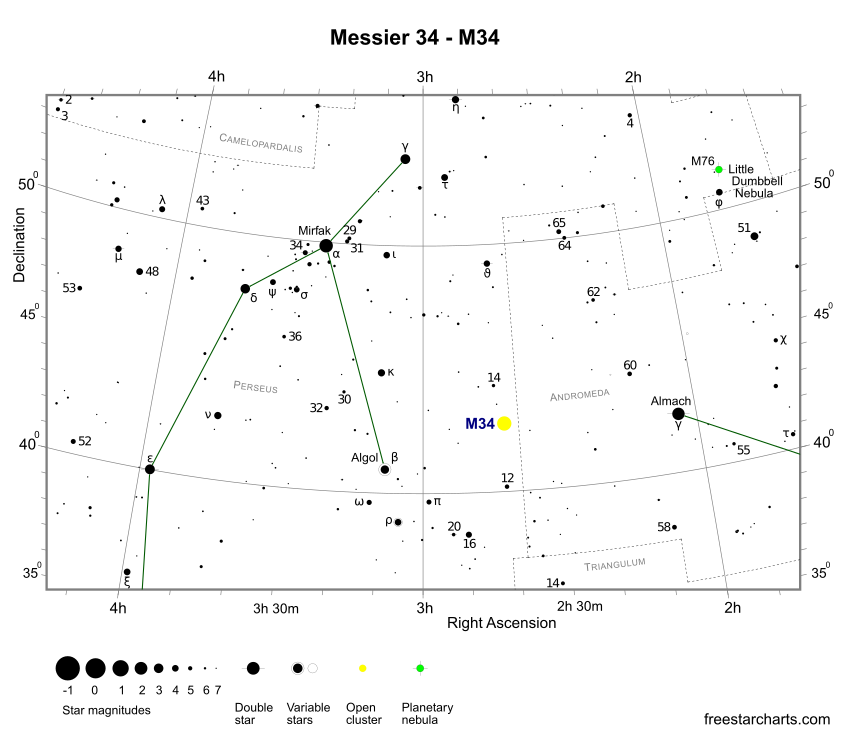M34 is a fine large loose open cluster located in the constellation of Perseus. At magnitude +5.5, it's visible as a faint smudge to the naked eye (from a reasonably dark site) and is easily identifiable with binoculars, where the brightest members are resolvable. A small telescope reveals up to 20 bright stars embedded in nebulosity with about 80 members visible in large amateur scopes.
M34 was probably discovered by Giovanni Batista Hodierna sometime before 1654. Charles Messier rediscovered it on August 25, 1764. He then included it in his catalogue describing it as, "A cluster of small stars a little below the parallel of γ (gamma) And. In an ordinary telescope of 3 feet one can distinguish the stars". M34 along with Little Dumbbell Nebula (M76) are the only Messier objects in Perseus. Finding this open cluster is easy. It's positioned on the western side of Perseus next to the Andromeda boundary and only 5 degrees northwest of famous eclipsing binary star, Algol. M34 lies about halfway along a line connecting Algol with beautiful telescopic multiple star, Almach.


Finder Chart for M34 - pdf format (credit:- freestarcharts)
As previously mentioned, M34 is faintly visible to the naked eye and a fine binocular object. It's a large cluster that covers 35 arc minutes of apparent sky, which is more than that of the full Moon. When viewed through a small 80mm (3.1-inch) telescope, the brighter stars of the cluster appear prominent with many fainter members also visible especially when using averted vision. At low powers, the cluster nicely fills a good portion of the eyepiece field of view. Towards the center are a couple of double stars. Through a 150mm (6-inch) or 200mm (8-inch) scope, dozens of stars are revealed and the loose scattered look of the cluster is pronounced. The bright stars towards the centre of the group form three arms that radiate outwards in a distinct "Y" or "V" shape.
M34 is about 200 Million years old, which is much older than the two components of the Double Cluster in Perseus (NGC 869 and NGC 884 - 5.6 and 3.2 million years old respectively), the famous Pleiades (M45) cluster (115 million years old) but younger than the Hyades cluster (625 million years old).
The cluster contains up to 400 stars of which at least 19 members have been identified as white dwarfs. It's best seen from the Northern Hemisphere during October, November and December.
M34 Data Table
| Messier | 34 |
|---|---|
| NGC | 1039 |
| Object Type | Open cluster |
| Constellation | Perseus |
| Distance (light-years) | 1,500 |
| Apparent Mag. | +5.5 |
| RA (J2000) | 02h 42m 07s |
| DEC (J2000) | +42d 44m 46s |
| Apparent Size (arc mins) | 35 x 35 |
| Radius (light-years) | 7.5 |
| Age (years) | 200 Million |
| Number of Stars | >80 |
| Other Name | Collinder 31 |